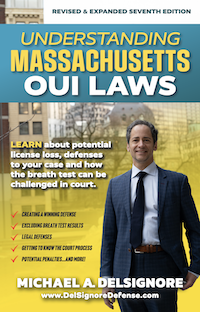Massachusetts OUI Motor Vehicle ManSlaughter
An OUI accident causing the death of another person can be charged as a Motor Vehicle ManSlaughter under Massachusetts General Laws Chapter 265 Section 13 (1/212).
To prove. A Motor Vehicle Manslaughter the Commonwealth would have to prove the following:
- That the defendant caused the Victim’s death;
- That the defendant intended the conduct that caused the Victim’s death.
- That the defendant’s conduct was Wanton or Reckless.
Wanton or Reckless conduct involves intentionally conduct which involves a high degree of likelihood that substantial harm will result.
The Courts have stated what must be intended is the conduct not the harm that results.
The Commonwealth can prove wanton or reckless conduct under a subjective standard or objective standard.
What most be proven under a Subjective and Objective Standard?If under a subjective standard the defendant’s own knowledge or grave danger to others must have been apparent and the defendant must have chosen to run the risk than alter his or her conduct.
If based on an objective standard, looking at an objective standard did the defendant’s actions constitute wanton or reckless conduct.
Conviction of OUI Manslaughter requires the following:
- That the defendant caused the victim’s death
- That the defendant intended the conduct that caused the victim death
- And that the defendant was wanton or reckless
- And was under the influence of alcohol meaning, the Commonwealth can prove,
That the defendant operated a motor vehicle, on a public way while under the influence of alcohol or with a breath or blood alcohol above.08 percent.
Maximum penalty for OUI Manslaughter:
What is the difference between OUI Manslaughter and Felony Motor Vehicle HomicideG.L. 90 Section 24G(a)
- On a public way
- While operating. A motor vehicle
- Under the influence of alcohol
- Operator a motor vehicle negligently or recklessly so that the lives or safety of the public might have been endangered.
- Caused the victim’d death.
A finding of ordinary negligence is sufficient to sustain a conviction under the Felony motor Vehicle Homicide statute.
The difference between Felony Motor Vehicle Homicide and Manslaughter by Motor Vehicle is the level of negligence. Manslaughter requires wanton or reckless conduct while Felony Motor Vehicle statute only requires ordinary negligence.
Manslaughter by motor vehicle is reversed for cases where a defendant is highly intoxicated and the driving is particularly egregious.
What are the Potential Penalties for OUI ManSlaughterOUI Manslaughter carries with it the potential penalty of a maximum State prison sentence of 20 years with a minimum State Prison Sentence of Five years.
Felony Motor Vehicle Homicide carries a possible State prison sentence of up to 15 years but allows for a House of Correction Sentence with a maximum house of correction sentence at 2,5 years and a minimum sentence at one year.
Reduction of the Charge:
A Motor Vehicle Manslaughter charge carries a substantial minimum mandatory jail sentence. One approach would be to seek a reduction of the charge in exchange for a plea on a lesser offense. This could include a charge of Felony or even Misdemeanor Motor Vehicle Homicide.
What should you do while the case is pending?Many people ask when a criminal charge is pending what they can do to help the case. Since we will want to see what the Commonwealth would offer on a plea, you should do the following right away:
- Continue working and supporting your family to the extent you can.
- Enroll in alcohol treatment or any counseling that lead to the criminal charges;
- Obtain letters of support from people that can attest to your good character.
If you have questions on how best to handle a charge of OUI Motor Vehicle Homicide, feel free to call or texts Attorney DelSignore at 781-686-5924. It is never too early or late to call; we are always here to help and answer your questions when you face Criminal Charges.
 New Bedford Criminal Lawyer DelSignore Law Home
New Bedford Criminal Lawyer DelSignore Law Home
